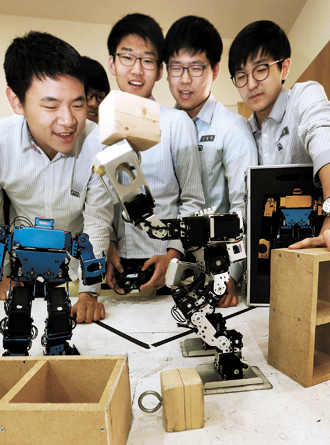Admissions look to in-school clubs

Members of the humanoid robot club at Sangmoon High School in Seocho District, southern Seoul, smile as they watch their projects function properly. By Choi Seung-sik
The teenagers separated off into pairs and each took turns following instructions as their teacher directed them to cut the organ vertically along the blood vessels.
“I don’t really envy [the kids who attend] special-purpose high schools because I’m experiencing things they don’t even teach you in private academies,” said Sohn Hyun-soo, an 11th-grader from Gangseo High School who attended the lesson. “I can also add these activities in my school record book, which will help me get into medical school.”
Special-purpose high schools include foreign-language high schools and science schools, which are generally considered elite in Korea.
However, the students participating in the biology lesson that day were all members of a group from eight unrelated non-special-purpose high schools - or regular high schools - who regularly convene after class to study medicine and life science.
The club was established in 2011 after local universities announced that they would place more emphasis on extracurricular activities held within an applicant’s own school during the admission process.
“With the help of other schools, we’re able to design diverse educational programs without stressing out our faculty members and students,” said Hwang Byung-won, a college admissions adviser from Gangseo High School.
But as nationwide universities pledge to select more students through early admissions, rather than regular admissions, a look at their revised evaluation criteria has raised concerns over the programs available at many regular high schools.
Starting this year, students will be banned from including in cover letters or teachers’ recommendations extracurricular activities completed outside of their school, which hints at the possibility that after-hours programs held within schools will become the focus of a successful college admission.
Educational pundits fear that such a change will only wreak havoc on Korea’s 1,525 regular high schools - many of which lack specific and substantial resources for extracurricular activities - just what the government was aiming against.
“Special-purpose high schools and autonomous private high schools increased the number of their after-school programs early on,” said Haneul Education Center CEO Lim Sung-ho.
He added that regular high schools face the risk of not having a contingency plan.
“I have a child taking the natural sciences track at a regular high school,” said one mother, surnamed Kim, from Yangcheon District, southwestern Seoul, “but he recently joined a Japanese club because his school didn’t have a scientific research club.
“I regret not having sent him to a special purpose high school or an autonomous private high school,” she confessed.
Research conducted by Haneul Education shows that approximately 30 percent of 149 regular high schools in Seoul operate only a single club.
By contrast, Hankuk Academy of Foreign Studies (HAFS), a foreign-language high school in Yongin, Gyeonggi, operates 188 clubs.
The average number of school clubs for every 100 students was 3.2 in regular high schools in Seoul; the corresponding figure for special-purpose high schools nationwide was 7.7, while autonomous private high schools had about 8.1, according to School Info, a government-affiliated organization.
“It really all comes down to what after-school programs high schools run,” said Lee Ji-hwa, 43, the mother of a middle school student who resides in Seocho District, southern Seoul. “In that sense, [sending my child to] a special-purpose high school or an autonomous private high school seems inevitable.”
In the past, most Korean parents inundated their children with information about extracurricular activities outside of their own schools, but now that those records will be prohibited from university admissions, such “motherly efforts” are useless, said Lee Young-deok, head of the Daeseong Academic Development Research Institute.
But some teachers at regular high schools argue that despite their efforts to improve after-school programs, students refuse to fall in line.
“Students here aren’t interested in studying, and they don’t even volunteer to participate in club activities,” said the principal of a regular high school in Gangseo District.
Nam Jun-hee, 60, a science teacher at Sangmoon High School in Seocho District, southern Seoul, also echoed that sentiment, but he didn’t stop at that. In 2008, Nam established a “science academy” at his school, in which 60 students are chosen to conduct a science experiment for four hours each week.
Professors and science high school teachers are invited to deliver special lectures, and students are guided throughout the year to write reports they later bind into a portfolio.
The portfolios are then submitted to colleges during the admissions process.
Although the annual membership fee for Nam’s science club is 840,000 won ($830), competition is fairly high, with three contenders for every one spot.
“I wanted to prove to my students that they, too, can study in an academic environment similar to that in science high schools,” Nam said.
To lay the groundwork for the club’s establishment, Nam toured special-purpose high schools nationwide and sought insight from instructors there, he said.
The science club grew so popular that Nam’s school now operates an English debate club, a humanoid robot club and a humanities club.
“I told the panel of [university] judges that I learned robot programming in high school,” said Han won-sik, 19, a graduate of Sangmoon High School, who was accepted to Soongsil University’s computing department this year.
“When I used jargon like ‘system circuit’ and ‘logic circuit,’ I saw their eyes light up,” he added.
Nam explained that most regular high schools are short on manpower, budget and facilities compared to special-purpose high schools or autonomous private high schools.
The secret, he said, is for teachers to show initiative in making the change.
BY SHIN JIN, KIM KI-HWAN, CHuN IN-SUNG, KIM SUNG-TAK [selee@joongang.co.kr]










with the Korea JoongAng Daily
To write comments, please log in to one of the accounts.
Standards Board Policy (0/250자)